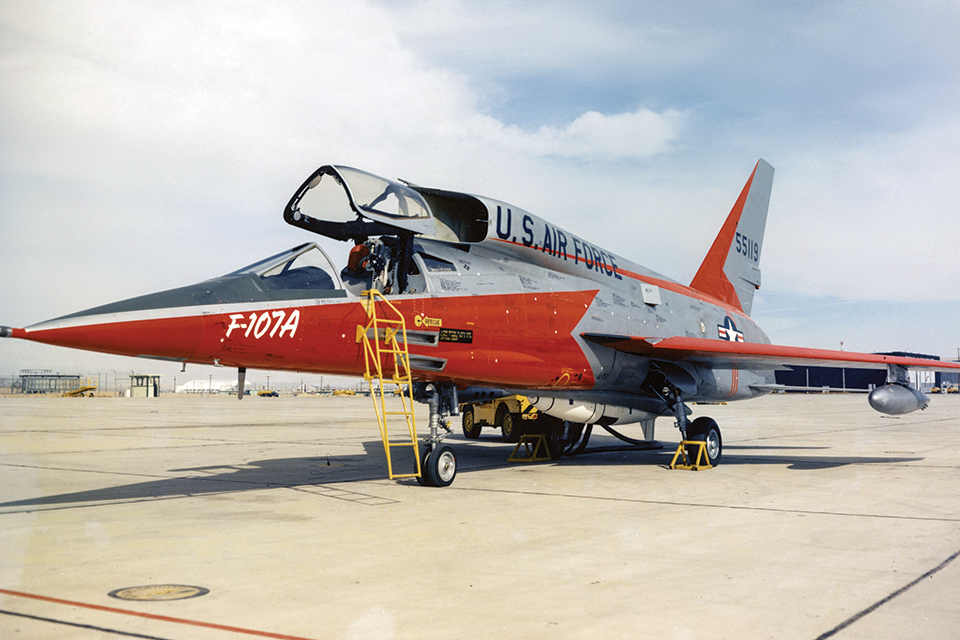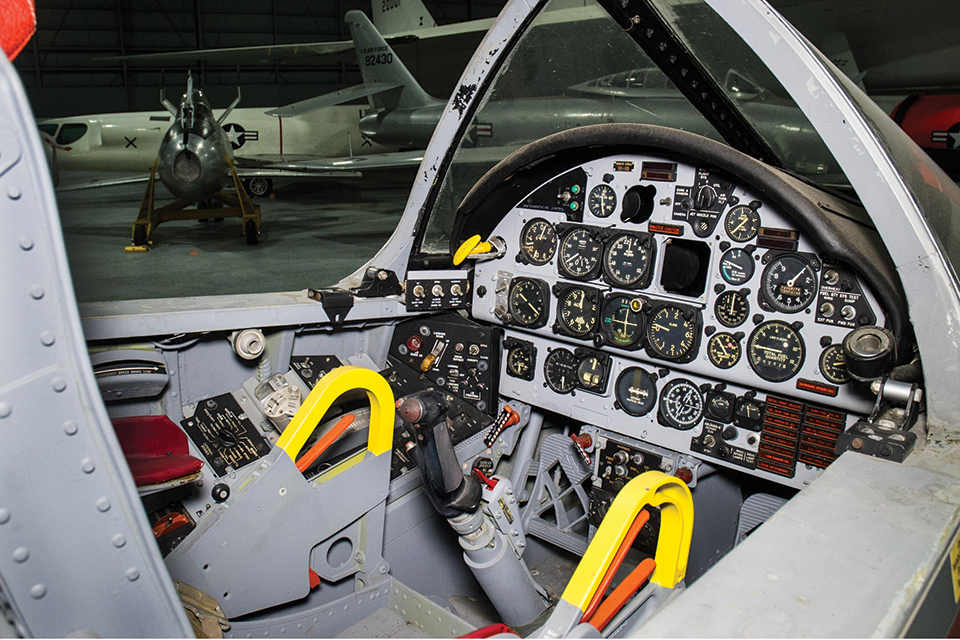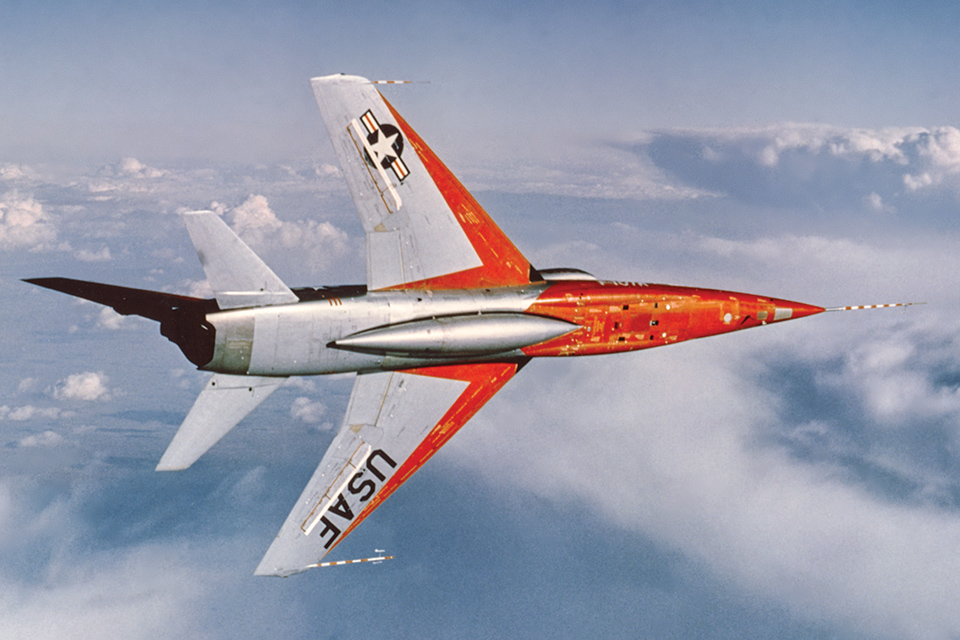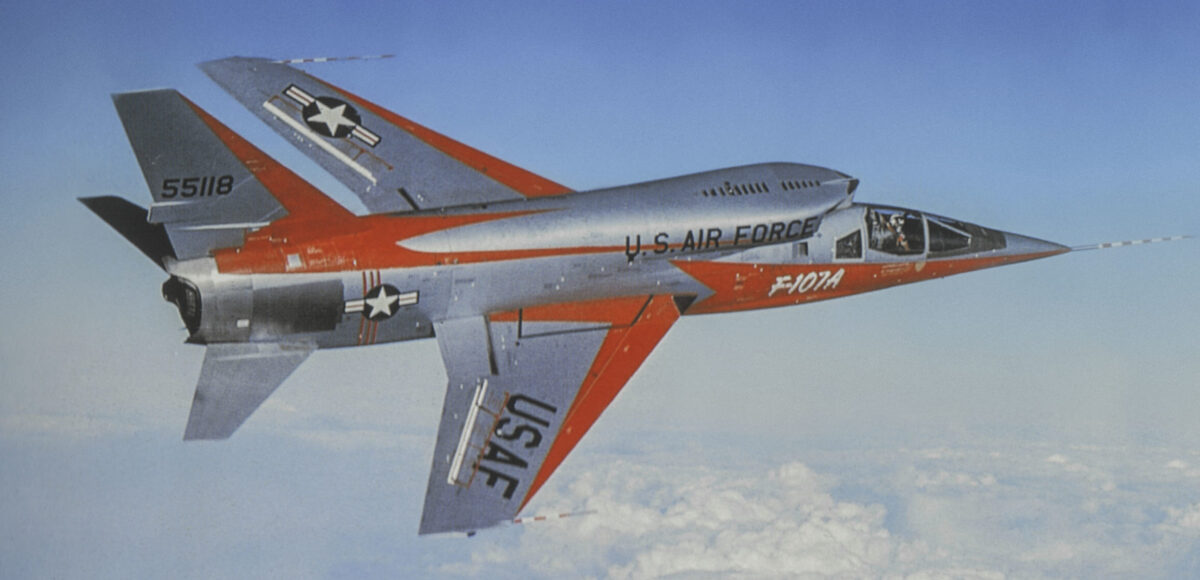North American Aviation’s F-107A was the last fighter created by the makers of the iconic P-51 Mustang of World War II, the F-86 Sabre of the Korean War and the F-100 Super Sabre of the Vietnam War. It was designed to satisfy a U.S. Air Force requirement for a Mach 2 fighter-bomber capable of delivering a tactical nuclear weapon. Originally conceived as a development of the F-100, the aircraft was initially designated XF-100B and it bore a family resemblance to the “Hun” when viewed from above. The design diverged so much from the F-100, however, that the Air Force issued it a separate designation. Although the F-107A was never given a name, it has sometimes been referred to as the “Super Super Sabre” or the “Ultra Sabre.”

First flown on September 10, 1956, the F-107 was considerably larger and heavier than the F-100, but it was powered by a Pratt & Whitney J75 turbojet delivering 24,500 pounds of thrust—50 percent more thrust than the Hun. The most distinctive visual difference between the two fighters was the deletion of the nose-mounted engine air intake of previous North American fighters in favor of a new variable-area inlet duct directly above and behind the cockpit. This was necessary to satisfy the Air Force’s nuclear-bomb-carrying requirement. The bomb was accommodated partly within a recess in the aircraft’s belly, taking up considerable space in the fuselage, which drove the decision to reroute the air intake above it.
Due to the unusual location of the air intake, the pilot squeezed into the cockpit under a special vertically opening canopy rather than via a conventional sliding or hinged canopy. In an emergency the ejection seat was designed to blast right through the canopy, though fortunately for all who flew it that particular feature never had to be used.
Although smaller than its hefty rival, the Republic F-105 Thunderchief, the F-107 was no midget at 61 feet 10 inches long, with a 36-foot-7-inch wingspan and a maximum takeoff weight of 41,537 pounds. The F-107 demonstrated a top speed of 1,295 mph, a range of 2,428 miles and a service ceiling of 53,200 feet.

North American had high hopes for the F-107’s future. There was even speculation that its production might be subcontracted out to rival Republic Aviation. Before it flew, however, the fate of the F-107 had already been sealed. The Air Force had ordered the F-105 into production six months earlier, in March 1956.
To this day some still consider the F-107’s abandonment a mistake and declare that it was the best fighter the Air Force never bought. The F-107’s superior rate of climb and higher ceiling in comparison to the F-105 are often mentioned, as are its many highly advanced features, such as augmented longitudinal control surfaces, a one-piece movable vertical tail and roll control via spoilers rather than ailerons. Some also point to the high losses sustained by F-105s over Vietnam.
There were a number of reasons, however, that could explain why the F-105 was chosen. The Thunderchief, which was also powered by the J75 engine, had a fully internal bomb bay and could carry 40 percent more ordnance (14,000 pounds of bombs and munitions—4,000 pounds more than the F-107’s payload). Moreover, ceiling and rate of climb were less important in aircraft intended for low-level strike missions, as were the F-105 and F-107. While the production F-105 had issues remaining to be ironed out, so did the F-107. As for the losses later sustained by “Thuds” over Vietnam, it is debatable whether any other aircraft could have performed better under similar operational conditions.

Perhaps the most important reason why the F-105 was chosen over the F-107 had more to do with the state of affairs at the two competing companies that developed them. At the time Republic Aviation was winding up production of its F-84 series of fighters and had nothing else in hand for the future. In contrast, North American was engaged in a great deal of development work on several important new defense projects, including the A-5 Vigilante carrier-based nuclear bomber for the Navy, the XB-70 Valkyrie Mach 3 strategic bomber for Strategic Air Command and the XF-108 Rapier Mach 3 interceptor for Air Defense Command. In the late 1950s all three of those projects were expected to be at the cutting edge of the next generation of U.S. air power. Nobody at that time could have foreseen that, of the three, only the Vigilante would ever enter production and become operational. The XB-70 was canceled during the mid-1960s when it became clear that ballistic missiles constituted a far more effective and less vulnerable nuclear deterrent than any manned bomber. As for the XF-108 Rapier, which was intended to replace the Convair F-106 Delta Dart as the North American continent’s principal air defense against incoming Soviet supersonic bombers, that project was canceled in 1959 while still in the mockup stage due to its high cost.
Only three F-107As were ever completed, of which two survive. One is housed in the National Museum of the U.S. Air Force in Dayton, Ohio, while the other is at Arizona’s Pima Air & Space Museum. The third was damaged during an aborted takeoff on September 1, 1959. Fortunately the test pilot, the famous Scott Crossfield, survived the mishap, but the aircraft was not repaired and was eventually destroyed during firefighting training a few years later.
This article originally appeared in the May 2021 issue of Aviation History.
Ready to build your own Ultra Sabre? Check out our exclusive online modeling column!






